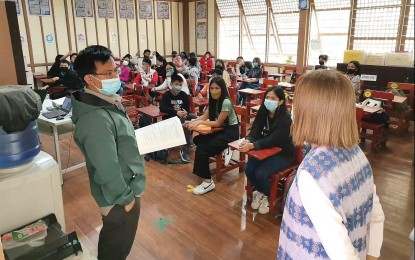
REMEDIES. A classroom at the Rizal Elementary School in Baguio City. Dr. Estela Cariño (standing, right), director of the Department of Education – Cordillera, said in an interview on Thursday (Nov. 3, 2022) that they are seeking remedies to overcrowding in public school classrooms, which prevents some schools from holding in-person classes. (PNA photo courtesy of DepEd-Cordillera)
BAGUIO CITY – The Department of Education (DepEd) in the Cordillera region is coming up with measures to address overcrowding in public school classrooms.
Dr. Estela Cariño, DepEd-Cordillera director, said these include shifting, splitting of classrooms, and removal of some pieces of furniture and fixtures.
“Ang inikot muna namin (We first went to) Baguio City. They have three – Rizal (National High School), Roxas (National High School), and Kias (National High School and Elementary School),” Cariño said in an interview on the sidelines of the 3rd Cordillera Gender and Development Focal Point System Assembly here Thursday.
At the Roxas National High School, senior high school classes are implementing blended learning with 65 enrollees in a class, hence the need to split it.
Meanwhile, she said the school’s Grade 7 to 10 learners are now having full face-to-face classes.
Learners at the Rizal National High School have a class size of 50 to 60 learners per classroom.
"Upon my assessment, what we can do is to prioritize Grade 7 in the full face-to-face," Cariño said, explaining that they have not been in school for two years, having finished their last two years in elementary doing the modular system.
This, she said, makes them the priority to have full face-to-face classes.
Cariño said they hope to start with the full face-to-face classes for Grade 7 learners by next week.
In Kias National High School and Elementary School, however, the solution is to remove a room’s contents, which will be done with the help of the Parent Teachers Association (PTA) and the village officials, she said, adding that they hope to implement full face-to-face classes at the elementary school on November 15.
Cariño said other issues found during their visit on November 2 are two shifts at Kias Elementary School, which poses safety risks among the learners who are in elementary and who are dismissed at 5 p.m.
"They are having transportation problems aside from safety due to the darkness of the surroundings at the time they go home," she said.
Cariño said they opted to divide the classroom instead as a solution in Kias Elementary School.
She noted that a full face-to-face for all levels would mean an overload in tasks for teachers, which may result in more problems.
“We instructed the division superintendent of Baguio to raise the possibility of the School Board hiring additional teachers,” Cariño said.
She also cited the damage caused by the recent earthquake and the onslaught of Severe Tropical Storm Paeng to some classrooms, including classrooms in Bokod, Benguet due to the landslide that occurred during the height of the storm.
She added that in other provinces in the region, such as Abra, there was no change in the number of schools that are implementing face-to-face classes because of the existence of the temporary learning shelters that were set up after the earthquake in July.
The Department of Education earlier ordered public schools to implement full in-person classes by November 2, while private schools have been allowed to continue blended learning modalities. (PNA)
